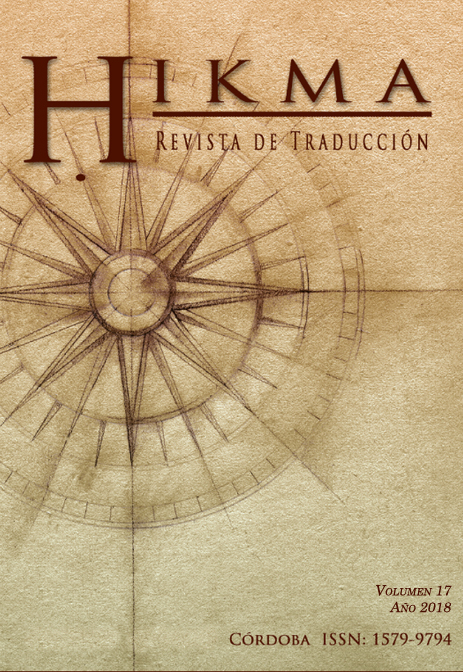Indexing a Gender Identity in Fictive Dialogue: Bucholtz and Hall’s Identity Principles in Translation
Contenu principal de l'article
Résumé
The framework for the analysis of identity construction proposed by Bucholtz and Hall (2005) has proved a useful heuristic tool for the study of identity formation in interaction. The aim of this article is to tentatively apply the model to fictive dialogue in translation and test its validity in two ways, firstly, as a framework for the descriptive analysis of identity formation in translation, and secondly, as a tool that can aid the translation of fictive dialogue.
The case study is Janice Angstrom, wife of the eponymous Harry Angstrom, in Updike’s «Rabbit» books. Using Bucholtz and Hall’s model, the descriptive analysis will compare the source and target texts for discursive mismatches that distort the intersubjective construction of her identity in interaction. The metapragmatic information yielded by the application of the model will then inform the proposed alternatives, guided by the principles of the model.
Téléchargements
Details de l'article

Ce travail est disponible sous licence Creative Commons Attribution - Pas d’Utilisation Commerciale - Partage dans les Mêmes Conditions 4.0 International.
Les auteurs qui publient dans cette revue acceptent les conditions suivantes :
- Les auteurs conservent les droits d'auteur et accordent à la revue le droit de première publication du travail simultanément sous une Licence Creative Commons Attribution, permettant à d'autres de partager le travail en reconnaissant la paternité du travail et sa publication initiale dans cette revue.
- Les auteurs peuvent conclure des accords contractuels supplémentaires séparément pour la distribution non exclusive de la version publiée du travail dans la revue (par exemple, l'envoyer à un référentiel institutionnel ou le publier dans un livre), avec une reconnaissance de sa publication initiale dans cette revue.
- Il est permis et encouragé aux auteurs de publier leurs travaux en ligne (par exemple, dans des référentiels institutionnels ou sur leur site Web) avant et pendant le processus de soumission, car cela peut entraîner des échanges productifs, ainsi qu'une citation plus précoce et plus importante du travail publié (voir L'effet de l'accès ouvert).
Références
Assis Rosa, A. (2015). Translating orality, recreating otherness. Translation Studies, 8(2), pp. 209-225. DOI: https://doi.org/10.1080/14781700.2015.1017833
Berman, A. (2000). Translation and the trials of the foreign. In Venuti, L. (Ed.), The Translation Studies Reader (pp.276-289). London and New York: Routledge.
Berthele, R. (2000). Translating African-American Vernacular English into German: the problem of “Jim” in Mark Twain’s Huckleberry Finn. Journal of Sociolinguistics, 4(4), pp. 588-613. DOI: https://doi.org/10.1111/1467-9481.00131
Boswell, M. (2001). John Updike’s Rabbit Tetralogy: Mastered Irony in Motion. Columbia: University of Missouri Press.
Brumme, J. (2012). Traducir la voz ficticia. Berlin and Boston: Walter de Gruyter. DOI: https://doi.org/10.1515/9783110263268
Brumme, J. and Espunya, A. (2012). The Translation of Fictive Dialogue. Amsterdam and New York: Rodopi. DOI: https://doi.org/10.1163/9789401207805
Bucholtz, M. and Hall, K. (2005). Identity and interaction: a sociocultural linguistic approach, Discourse Studies 7(4-5), pp.585-614. DOI: https://doi.org/10.1177/1461445605054407
De Bellis, J. (2000). The John Updike Encyclopedia. Westport, Connecticut and London: Greenwood Publishing Group. DOI: https://doi.org/10.5040/9798400674679
Del-Tese-Craviotto, M. (2008). Gender and sexual identity authentication in language use: the case of chat rooms. Discourse Studies, 10(2), pp.251-270. DOI: https://doi.org/10.1177/1461445607087011
Eckert, P. (1990). The whole woman: sex and gender differences in variation. Language Variation and Change, 1(1989): pp. 245-267. DOI: https://doi.org/10.1017/S095439450000017X
Eckert, P. and McConnell-Ginet, S. (2003). Language and Gender. Cambridge: Cambridge University Press. DOI: https://doi.org/10.1017/CBO9780511791147
Gordon, M. (1991). Good and Dead Girls: And Other Essays. New York: Viking.
Johnstone, B. (2010). Locating language in identity. In Watt, D. and Llamas, C. (Eds.), Language and Identities (pp. 29–36). Edinburgh: Edinburgh University Press. DOI: https://doi.org/10.1515/9780748635788-007
Joseph, J. (2004). Language and Identity: National, Ethnic, Religious. New York: Palgrave Macmillan. DOI: https://doi.org/10.1057/9780230503427
Leppihalme, R. (2000). The two faces of standardization: on the translation of regionalism in literary dialogue. The Translator, 6(2): 247–69. DOI: https://doi.org/10.1080/13556509.2000.10799068
Litosseliti, L and Sunderland, J (2002) Gender Identity and Discourse Analysis. Philadelphia and Amsterdam: John Benjamins Publishing. DOI: https://doi.org/10.1075/dapsac.2
Livia, A. (2003). ‘One man in two is a woman’: linguistic approaches to gender in literary texts. In Holmes, J. and Meyerhoff, M. (Eds.), The Handbook of Language and Gender (pp. 142–58). Oxford: Blackwell. DOI: https://doi.org/10.1002/9780470756942.ch6
Määttä, S. (2004). Dialect and point of view: the ideology of translation in The Sound and the Fury in French. Target 16(2): pp. 319-339. DOI: https://doi.org/10.1075/target.16.2.06maa
Mango, O. (2010). Enacting solidarity and ambivalence: positional identities of Arab American women. Discourse Studies 12(5): pp. 649-664. DOI: https://doi.org/10.1177/1461445610371056
Ochs, E. (1992). Indexing gender. In Duranti, A. and Goodwin, C. (Eds.), Rethinking Context: Language as an Interactive Phenomenon (pp. 335-358). Cambridge: Cambridge University Press.
Pinto, S. (2009). How important is the way you say it? A discussion on the translation of linguistic varieties. Target 21(2): pp. 289–307. DOI: https://doi.org/10.1075/target.21.2.04pin
Sidiropoulou, M. (2004). Linguistic Identities through Translation. Amsterdam and New York: Rodopi. DOI: https://doi.org/10.1163/9789004486652
Simon, S. (1996). Gender and Translation. Culture and Identity and the Politics of Transmission. London and New York: Routledge.
Simons, M. (1983). The silencing of Simone de Beauvoir: guess what’s missing from The Second Sex. Women’s Studies International Forum 6(5): pp. 559-564. DOI: https://doi.org/10.1016/0277-5395(83)90081-X
Updike J. (1960). Rabbit, Run. New York: Knopf
Updike J. (1971). Rabbit Redux. New York: Knopf
Updike J. (1981). Rabbit is Rich. New York: Knopf
Updike J. (1990). Rabbit at Rest. New York: Knopf
Updike, J. (1990). Corre, Conejo. (Trans: Fibla, J.) Barcelona: Tusquets Editores.
Updike, J. (1992). Conejo en Paz. (Trans: Menéndez, I.) Barcelona: Tusquets Editores.
Updike, J. (1993). El regreso de Conejo. (Trans: Menéndez, I.) Barcelona: Tusquets Editores.
Updike, J (2003). Conejo es rico. (Trans: Zulaika, J.) Barcelona: Tusquets Editores.
Von Flotow, L. (1997). Translation and Gender: Translating in the ‘Era of Feminism’. Manchester: St Jerome Publishing. DOI: https://doi.org/10.1353/book6616
Watt, D. (2010). The identification of the individual through speech. In Watt, D. and Llamas, C. (Eds). Language and Identities (pp. 76–85). Edinburgh: Edinburgh University Press. DOI: https://doi.org/10.1515/9780748635788-011
Wolfram, W. and Schilling-Estes, N. (2006). American English: Dialects and Variation. Cambridge and Oxford: Wiley and Blackwell Publishing.

